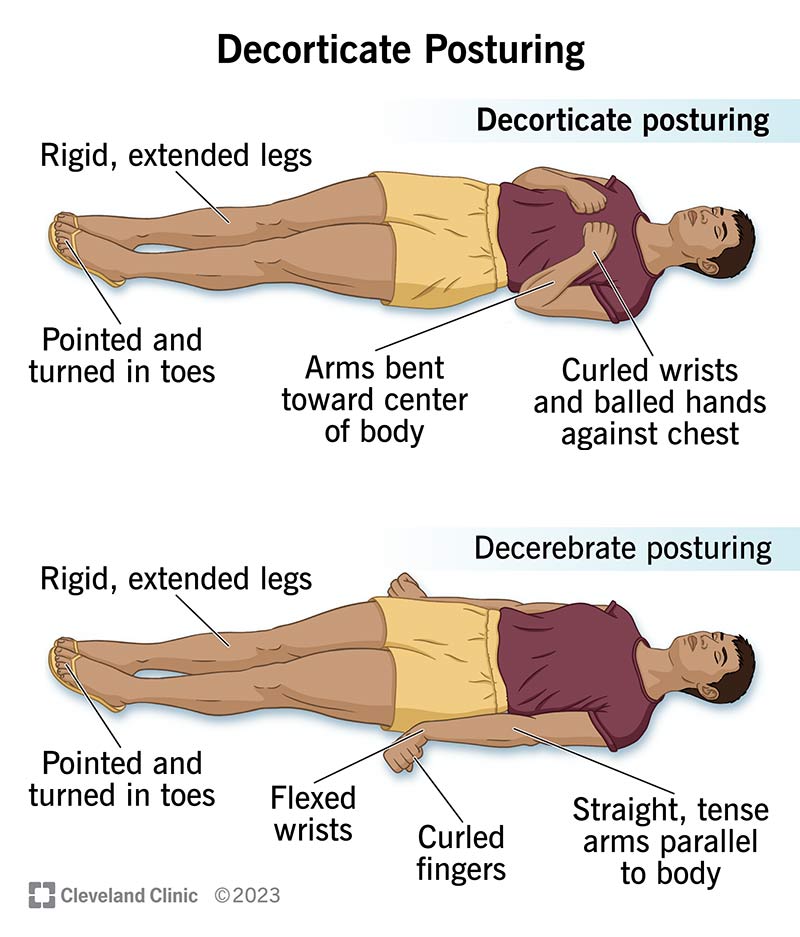Decerebrate posturing involves a reflex movement of muscle groups throughout your body, causing your limbs to extend and hold rigidly. These movements can happen automatically when there’s severe damage to your brain or major disruptions in brain function. Some conditions that cause it are treatable, but most people with this symptom don’t survive.
Advertisement
Cleveland Clinic is a non-profit academic medical center. Advertising on our site helps support our mission. We do not endorse non-Cleveland Clinic products or services. Policy

Image content: This image is available to view online.
View image online (https://my.clevelandclinic.org/-/scassets/images/org/health/articles/24969-decorticate-posturing)
Decerebrate posturing is a position your body may assume automatically because of damage to or disruptions in your brain. It’s sometimes called “decerebrate rigidity.” It can be a symptom of brain injuries and many different medical conditions.
Advertisement
Cleveland Clinic is a non-profit academic medical center. Advertising on our site helps support our mission. We do not endorse non-Cleveland Clinic products or services. Policy
Decerebrate posturing (pronounced “dee-sair-ebb-rate”) causes certain muscle groups throughout your body to automatically tense up. It can affect one side of your body or both. When decerebrate posturing affects only one side, the affected side takes on the positions described below. The unaffected side doesn’t.
A person with decerebrate posture can have the following:
People who have this posturing are always unconscious and in a coma. That means they don’t wake up or respond, even with strong prompting and efforts to wake them. Decerebrate posturing is one of the indicators that healthcare providers use when assessing coma using the Glasgow Coma Scale.
Decerebrate posturing usually (but not always) indicates one or more lesions affecting specific parts of your brain: the lower midbrain or pons. Your brainstem links your brain to your spinal cord, and your midbrain is the upper part of your brainstem. The pons is the section of your brainstem immediately below your midbrain.
Advertisement
Conditions that can cause decerebrate posturing include (but aren’t limited to):
Decerebrate posturing isn’t treatable directly. The only option is to treat the underlying condition that’s causing it (if possible).
Because people who have decerebrate posturing are most likely in a coma, they may also not be able to breathe on their own. Supportive care options, like mechanical ventilation or other treatments that help maintain body systems during a coma, are also likely.
Because there are so many conditions that can cause decerebrate posturing, the treatment options vary widely. A healthcare provider is the best person to tell you about possible treatments.
Decerebrate posturing means that there’s severe damage to your brain or something is causing major disruptions in brain activity. They can cause permanent damage, which can cause a person to lose abilities that their damaged brain areas once controlled. In the most severe cases, the conditions that can cause decerebrate posturing are deadly without treatment.
Many conditions that cause decerebrate posturing are preventable, or you may be able to reduce your chances of developing them. Some things you can do include:
Advertisement
A person with uncontrolled muscle movements of any kind when unconscious and unresponsive (meaning they don’t wake up when you try to rouse them) needs immediate medical care. Call 911 (or your local emergency services number) right away.
Recovery from a condition that causes decerebrate posturing may be possible, depending on the underlying cause. Recovery is most likely to happen when the cause is a condition or event that’s reversible or treatable.
However, even with treatment, decerebrate posturing tends to have an unfavorable outlook. Unfortunately, most people who have it don’t survive.
It can be scary to see someone you know or care about experiencing a symptom like decerebrate posturing. This symptom often happens when someone is in a coma because of a severe illness or injury affecting their brain.
But advances in modern medicine mean there are more ways to diagnose and treat the conditions that can cause it. Researchers continue to find new ways to help treat the conditions that cause decerebrate posturing, offering hope to those who have a loved one affected by them.
Advertisement
Learn more about the Health Library and our editorial process.
Cleveland Clinic's health articles are based on evidence-backed information and review by medical professionals to ensure accuracy, reliability, and up-to-date clinical standards.
Cleveland Clinic's health articles are based on evidence-backed information and review by medical professionals to ensure accuracy, reliability, and up-to-date clinical standards.
If you have a neurological condition, you want expert advice. At Cleveland Clinic, we’ll work to create a treatment plan that’s right for you.
